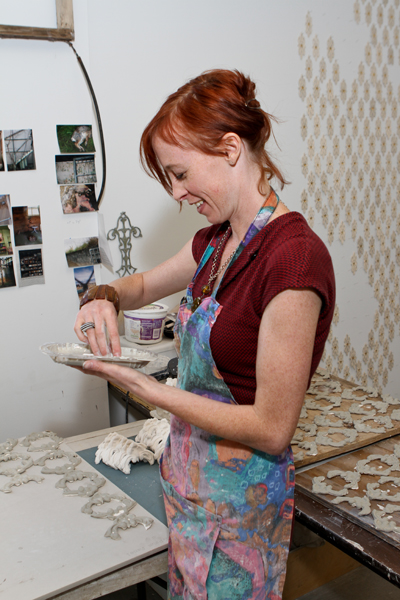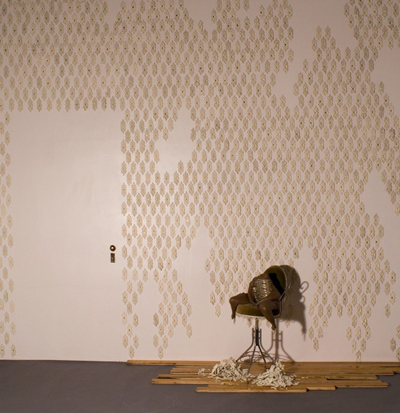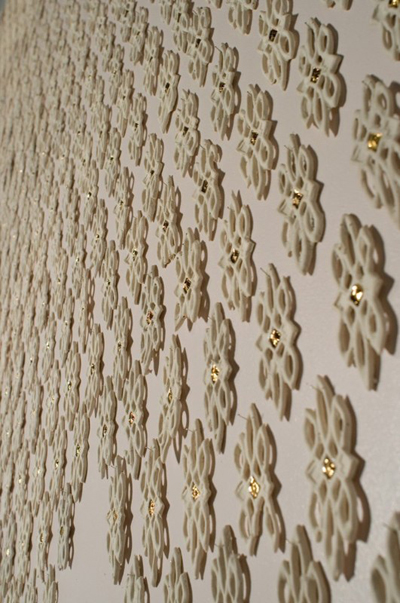
This week, we interviewed Jessica Kreutter, a clay artist who works with discarded objects. She received an MFA from The University of Tennessee in 2010. For 10 years previous to graduate school, she worked as an artist, art teacher and social worker in Portland, Oregon. Recently, she has exhibited at Pirate: Contemporary Art, Mütter Museum, Seattle Design Center, and the Fort Collins Museum of Art, as well as in group exhibitions in Philadelphia, Washington, Florida, Kentucky, North Carolina, and Colorado. She has been a resident artist at ART342, Vermont Studio Center, Anderson Ranch and Platte Forum and is in residence at HCCC through August 15, 2012.
You work in a studio with a large window, which makes you more visible to the Center’s visitors than the other artist studios. Do you feel that the high visibility is a hindrance or an incentive to work?
Neither, to any large degree. I just find myself tailoring what I am working on depending on what is going on at the Center. I cherish the time after hours, when I can work in privacy, listen to music, sing and talk to myself. These are times when I can think, make decisions and start to more fully understand the work (by staring blankly at the wall). During open hours, I focus more on physically making the work. I can mentally block out the window so that I can fully engage with what I am doing, and I just have to remember to not pick my nose and to keep my clothes on.
Can you tell us about the processes you use?
Everything is hand built. Lately, I’ve been collecting ornamentation from objects, wood filigrees in Victorian houses, and any interesting ornate design by making a simple one-part mold out of clay. After firing the mold, I can press wet clay into the bisque and remake these designs. This ornamentation shows up in the pieces—in the repetitive fragments or on the larger “bodies.”
What led you to combine porcelain sculpture with found objects?
I like to explore abandoned places or places on the margins. I’ll go on hikes/drives and come across interesting places to explore or find places when I travel, like the Salton Sea, the Sutro baths or a town on the edge of Death Valley. I just enjoy the act of exploring and taking photos. As I started to think about what I was searching for in these places, I realized it connected with what I was searching for in my own work—a space of transition, a place between two worlds. So I started to compile objects that I would find and bring them into my work.
Does the sense of age in the objects play a large role?
The wear and decay speak to me about memory and time and transformation. I think of all the bodies that have used the objects as they move through time, leaving both visible and invisible traces. In a place of fantasy and imagination, what happens when these traces float free of associations, and how is memory transformed into a tangible presence?


Do you feel it is important to tailor your pieces to the final installation space?
Making a piece to fit a space is much like finding an object and figuring out how the clay will relate to the object. It forces you to work differently, because you are starting out with a certain set of existing problems. In that way, I do like to know the space in which the piece will exist and work within the perimeters. Lately, I have been working with lots of parts and pieces that can conform to any space, making it easy for the piece to shift and change. I like this as well, because it leaves some decisions open, and you don’t quite know the piece until the very end.
You’ve worked in fields ranging from the arts to social work. How would you say these experiences inform your current visual output?
The experience of making can be very solitary, and sometimes it is hard not to see it as a selfish venture done in isolation. It is very hard to know if and how the work affects the outside world. I see my work teaching and working/volunteering in social service as a counter balance to my work as an artist. The experience of witnessing others find their own creativity and voice gives me an understanding of why I do what I do and reminds me that art does hold an important place in the world.
What do you think about the Houston arts community?
I have been surprised at the great contemporary art scene in Houston and its accessibility. On any given day, I can go sit in the Rothko chapel, take a book to read in the Dan Flavin installation and bike to the James Turrell Skyscape at sunset. This accessibility and commitment to great art leads people to incorporate art into their everyday lives and creates a supportive, thriving arts community.
What is your favorite thing about your residency at HCCC?
Bringing me to an unexpectedly great city and being able to have conversations that move beyond “what are you making” with some of the visitors and the residents.
Who was your biggest influence artistically?
I like the other worlds created by Remedios Varo. And I am constantly intrigued with other women that can loosely be connected with surrealism and the way they use the body, like Louise Bourgeois, Dorothea Tanning, Francesca Woodman.

